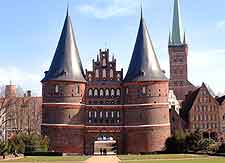Lubeck History Facts and Timeline
(Lubeck, Schleswig-Holstein, Germany)

Lubeck began life as a Christian settlement that was founded at the meeting place of the rivers Trave and Schwartau. It was known as Liubice, which means 'beautiful'. It did not survive for long though, as shortly afterwards, in 1028, the settlement was attacked and destroyed.
A new town was established by Earl Adolf III von Schauenburg, this time on the present-day site of the Old Town. In 1157, the town was destroyed in a fire. A few years later, a Saxon king, Henry the Lion, attempted to revive the town. Fortunately, he was successful and Lubeck quickly grew into a trading centre. Wine, salt and furs were shipped from here, amongst other goods.
Several churches were built during these early years of its history. The Cathedral (Dom), the Merchants' Church, St. Mary's Church (St. Marienkirche) and St. Peter's Church (St. Peterskirche) were all built during the early Middle Ages, along with three others. Indeed, most of the oldest parts of Lubeck were laid out in the 12th and 13th centuries.
In the year of 1226, Frederick II, Holy Roman Emperor, granted Lubeck the title of Free Imperial City. As such, it had a large degree of independence, and was answerable only to the emperor himself. The only obstacle to its continuing prosperity were the Danes, who under King Waldemar II occupied the city from 1201 to 1227. With their departure after the Battle of Bornhoved, any final obstacles were removed. In 1250, a defensive wall was built around the city, together with four gates. Two of these ancient gates are still in evidence today.
Early Modern History
From the 14th to the 16th century, Lubeck reached the height of its influence. At this time, it was part of the Holy Roman Empire. In 1329, the city purchased Travemunde, thus gaining unrestricted access to the Baltic Sea. In 1375, the Emperor Charles IV bestowed upon Lubeck the title of 'Glory of the Empire'. It was a title that was not used lightly - only four other cities, namely
Florence,
Pisa,
Rome and
Venice, shared it.
Although Lubeck managed to avoid getting embroiled in the Thirty Years' War, it couldn't save itself from the worst effects of the war between France and Prussia, which started in 1806. It wasn't until 1813 that Lubeck was finally freed of French occupation. However, by this time its power as a trading city had vastly diminished. In 1871, the city became an independent province within the German Kaiserreich.
History in the 20th Century
During World War Two, Lubeck was the first city in Germany to be subjected to substantial aerial bombing by British forces. In March 1942, the bombardment was so severe that it created a firestorm. Three of the city's main churches were destroyed, along with a large part of its historic centre. The bombing led to the retaliatory Baedeker Raids on British cities, which were ostensibly aimed at improving German morale. In May 1945, Lubeck was captured and occupied by Allied forces under British command.
Post-war Lubeck became part of Schleswig-Holstein within West Germany. It took several years to remove the majority of the city's waste and rubble. It took even longer to rebuild the oldest part of the city. In 1987, the city was rewarded for its efforts to preserve its rich history with the granting of UNESCO World Heritage Site status.
 Lubeck began life as a Christian settlement that was founded at the meeting place of the rivers Trave and Schwartau. It was known as Liubice, which means 'beautiful'. It did not survive for long though, as shortly afterwards, in 1028, the settlement was attacked and destroyed.
Lubeck began life as a Christian settlement that was founded at the meeting place of the rivers Trave and Schwartau. It was known as Liubice, which means 'beautiful'. It did not survive for long though, as shortly afterwards, in 1028, the settlement was attacked and destroyed.